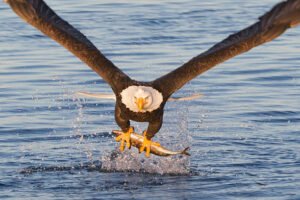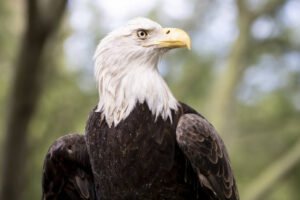
Introduction
Here, in the world of bald eagles, magnificent birds of prey that soar through the sky with unmatched strength and grace, welcome. Because of their majestic look and inspiring way of life, these well-known birds have long captivated people. There’s so much to learn about these amazing animals, from their unusual environment to their incredible hunting capabilities.
All right, let’s get out there and explore the fantastic world of bald eagles! Prepare to be in awe of their remarkable way of life, which has won over the hearts of both nature lovers and avian enthusiasts.
Habitat and Nesting Habits
The fantastic creatures that are bald eagles have specific preferences regarding their home. These untamed birds are found from Alaska to Mexico in North America. Large bodies of water, such as lakes, rivers, and coastal locations, are generally where they tend to end up. You may even see them close to marshes or wetlands. When these gorgeous birds decide to raise a family, they carefully select where to build their nests. In birds, bald eagles construct some of the most enormous nests! These nests, made of sticks and lined with soft materials like moss or feathers, can weigh hundreds of pounds and reach widths of up to ten feet.
Remarkably, bald eagles frequently return to the same nest every year. These nests grow into enormous buildings perched atop trees or cliffs as they accumulate more sticks and materials each season. The resilience with which these birds maintain such robust structures is astounding. Bald eagle parents who desire a safe area to raise their young must carefully consider their options regarding location. They choose towering trees with a view of broad areas to quickly identify nearby food sources or threats.
Both parents take turns providing the chicks (eaglets) with meticulous care after the eggs hatch. Hunting for food and defending the nest from intruders are two aspects of this joint duty. That’s everything for now—some fantastic information about bald eagle habitat preferences and breeding behaviors. These tremendous birds genuinely capture the elegance and majesty of the natural world.
Diet and Hunting Techniques
With their outstanding hunting skills and varied diet, bald eagles are renowned as fierce hunters. The majority of the food consumed by these magnificent birds is fish. They can seize fish from the water’s surface with remarkable quickness and precision thanks to their keen talons. They frequently use perching on trees or rocky outcrops near bodies of water as part of their hunting technique since they can easily see possible prey swimming below. Bald eagles use their strong wings to propel themselves ahead as they plunge forward at tremendous speeds toward the sea after they have found a suitable victim.

When the opportunity presents itself, bald eagles eat other small mammals, such as rats, rabbits, and fish. There have also been reports of them scavenging carrion and seizing quick meals whenever possible. Their capacity to adapt to their diet permits them to live even when fishing is not easily accessible. Bald eagles are adapted with solid beaks that can easily rip through flesh, which helps them to capture elusive prey that is hidden in vegetation or underwater. While flying at tremendous altitudes, their acute vision is essential for identifying possible targets at a distance. The hunting skills and nutritional choices of bald eagles are remarkably proficient and adaptable. Because of their adaptability, they can survive in various North American environments where they are the dominant predators.
Mating and Family Dynamics
Bald eagles are recognized for enduring relationships with their partners since they usually live together. These magnificent birds engage in an intricate mating ritual that includes vocal calls and impressive aerial gymnastics when looking for a mate. The eagles, male and female, will fly above the treetops in unison as they execute complex flight maneuvers.
Devoted Parents: In a lofty tree or on a cliff ledge, a pair will construct a sizable nest together after mating. These nests can grow to enormous proportions they can occasionally weigh several tons and measure up to 10 feet wide! Couples of bald eagles are loving parents who put up endless effort to raise their young.
Typically, during the breeding season, the female eagle lays one to three eggs. Until the eggs hatch into fluffy white chicks, both parents alternately incubate the eggs for roughly 35 days. After their child has hatched, the parents continue to work tirelessly to raise and defend their young. The chicks go through several developmental phases as they become older and eventually leave the nest. They may still be reliant on their parents for food and supervision for several months after they fledge, which occurs between 10 and 12 weeks of age.
Even after leaving the nest, bald eagles place a high value on family ties. In the seasons that follow, young people frequently go back to their birthplace or help take care of their younger siblings. This familial link demonstrates how meaningful family relationships are in bald eagle society.
It is incredible to watch the mating rituals of bald eagles and the commitment of these magnificent birds to raising offspring a demonstration of nature’s astonishing intelligence! Remember this the next time you see these fantastic birds soaring through the sky or perched magnificently on a limb overlooking wide-open spaces: beneath those sharp eyes is a complex world of love, dedication, and enduring relationships amongst families of the feathered monarchy.
Conservation Efforts and Popularity among Americans
An Example of a Successful Conservation Initiative: The Bald Eagle’s comeback has been greatly aided by conservation measures. The bald eagle has come to represent successful conservation efforts in the United States. These magnificent birds have miraculously recovered from the threat of extinction posed by habitat loss and pesticide use. A significant turning point for bald eagles was the outlawing of DDT, a dangerous poison that hindered their procreation capacity. Since then, countless government and conservation organizations have devoted innumerable hours to safeguarding their environment and guaranteeing their survival.

Legal Protection: The Bald Eagle Protection Act, enacted in 1940, forbids the killing or catching bald eagles without the required permits. Laws that designate these birds’ essential habitats, such as the Endangered Species Act, also offer further protection. Americans enthusiastically participate in their national bird’s safety and take tremendous delight in it. Many participate in citizen science initiatives, reporting sightings or watching nests. Programs for conservation education are also essential in bringing attention to these fantastic animals.
An Emblem of Strength and Freedom: It is understandable why bald eagles are so beloved by Americans, given their magnificent look and potent symbolic meaning. Across North America, these majestic animals evoke wonder and respect wherever they are spotted. We can keep these fantastic birds safe via our combined efforts, allowing future generations to see their magnificent flights over our skies! To protect this fantastic species for many more years to come, let’s all work together.
Symbolism and Cultural Significance of Bald Eagles
An emblem of Liberty: For many Americans, the bald eagle is particularly dear to their hearts. In addition to being a magnificent animal, it also serves as a potent metaphor for strength, tenacity, and independence. An iconic symbol in many civilizations, the eagle has enthralled humans with its piercing glance and soaring flight for millennia.
Native American customs: In Native American traditions, the bald eagle is seen as a messenger between the spiritual world and humanity and is, therefore, holy. Its feathers are frequently utilized in ceremonies as a symbol of strength, insight, and a link to the holy. Many cultures think seeing an eagle or its feathers will bring protection and good fortune.
National Emblem: This gorgeous bird has a symbolic meaning that the founding fathers of the United States acknowledged. They decided on the bald eagle as their national emblem in 1782 because they felt it embodied traits their fledgling country needed, such as bravery, independence, and grace. Eagles grew to symbolize national identity and patriotism over time. Embodying American principles such as freedom and liberty, they can be seen on official seals, currency, flags, and military insignias. One might feel proud of their country when seeing an eagle soar through the skies.
Worldwide Recognition: The bald eagle has been known as an ambassador species for conservation efforts worldwide, in addition to its cultural significance in North America. Their presence implies healthy ecosystems because they are apex predators at the top of their food chain. The sight of these majestic birds evokes awe. It serves as a reminder of the significance of protecting biodiversity globally in many locations worldwide where eagles do generally not occur.

Eco-Tourism and Conservation: Around the world, eco-tourism programs allow wildlife enthusiasts to get up close and personal with these unique species. This emphasizes even more how they serve as ambassadors for the glories of nature. Photographing wild birds in all their splendor and majesty generates revenue for nearby communities and helps to preserve their habitats over the long run. Bald eagles urge future generations to cherish and enjoy the environment through education and awareness programs.
FAQs
Q: Bald eagles can swim?
A: Indeed, bald eagles are good swimmers! It has been seen that they use their wings as oars to paddle across the water. Unlike several other bird species, they do not, however, dive underwater.
Q: How long are the lives of bald eagles?
A: In comparison to many other birds, bald eagles live pretty long lives. In the wild, their average lifespan is 20 to 30 years, yet in rare instances, reports of people living into their 40s and even early 50s have been made.
Q: Are bald eagles that way?
A: In contrast to what their name implies, bald eagles are not indeed “bald.” The word “bald” originates in an Old English phrase that means “white or shining head.” The characteristic white feathers on their heads and their huge yellow beaks make bald eagles easy to identify.
Q: Are these magnificent birds in jeopardy?
A: Fortunately, since the 1970s, when the bald eagle was categorized as an endangered species in the United States, its population has increased dramatically as a result of successful conservation efforts over time. They have achieved a fantastic recovery and are no longer regarded as endangered.
Q: Are bald eagle feathers allowed to be kept as souvenirs?
A: Under federal laws, such as the Bald and Golden Eagle Protection Act and the Migratory Bird Treaty Act, which safeguard migratory birds like the bald eagle, possessing any part of the bird—including feathers—is prohibited unless the U.S. Fish & Wildlife Service has issued the appropriate licenses or exemptions.
Q: “Soaring like an eagle”—what does that mean?
A: In a metaphorical sense, “soaring like an eagle” refers to someone accomplishing great things while overcoming challenges easily, as these fantastic birds glide through the sky on thermal updrafts to enable prolonged flight.
Q: What cultural significance do Bald Eagles have in the United States?
A: In American culture and symbolism, bald eagles represent strength, independence, and national identity. Being the national emblem and living examples of American principles, they are an essential component of the history and culture of the country.





